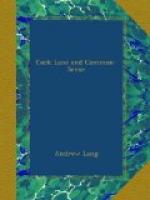From New Zealand Mr. Tylor cites, with his authorities, the following example: {353} ’A party of Maoris (one of whom told the story) were seated round a fire in the open air, when there appeared, seen only by two of them, the figure of a relative left ill at home. They exclaimed, the figure vanished, and, on the return of the party, it appeared that the sick man had died about the time of the vision.’ A traveller in New Zealand illustrates the native belief in the death-wraith by an amusing anecdote. A Rangatira, or native gentleman, had gone on the war-path. One day he walked into his wife’s house, but after a few moments could not be found. The military expedition did not return, so the lady, taking it for granted that her husband, the owner of the wraith, was dead, married an admirer. The hallucination, however, was not ‘veridical’; the warrior came home, but he admitted that he had no remedy and no feud against his successor. The owner of a wraith which has been seen may be assumed to be dead. Such is Maori belief. The modern civilised examples of death-wraiths, attested and recorded in Phantasms of the Living, are numerous; but statistics prove that a lady who marries again on the strength of a wraith may commit an error of judgment, and become liable to the penalty of bigamy. The Maoris, no statisticians, take a more liberal and tolerant view. These are comparatively scanty examples from savage life, but then they are corroborated by the wealth of recurrent and coincident evidence from civilised races, ancient and modern.
On the point of clairvoyance, it is unnecessary to dwell. The second-sighted man, the seer of events remote in space or not yet accomplished in time, is familiar everywhere, from the Hebrides to the Coppermine River, from the Samoyed and Eskimo to the Zulu, from the Euphrates to the Hague. The noises heard in ‘haunted houses,’ the knocking, routing, dragging of heavy bodies, is recorded, Mr. Tylor says, by Dayaks, Singhalese, Siamese, and Esths; Dennys, in his Folklore of China, notes the occurrences in the Celestial Empire; Grimm, in his German Mythology, gives examples, starting from the communicative knocks of a spirit near Bingen, in the chronicle of Rudolf (856), and Suetonius tells a similar tale from imperial Rome. The physician of Catherine de Medicis, Ambroise Pare, describes every one of the noises heard by the Wesleys, long after his day, as familiar, and as caused by devils. Recurrence and conformity of evidence cannot be found in greater force.
The anthropological test of evidence for faith in the rejected phenomena is thus amply satisfied. Unless we say that these phenomena are ‘impossible,’ whereas totemism, the couvade, cannibalism, are possible, the testimony to belief in clairvoyance, and the other peculiar occurrences, is as good in its way as the evidence for the practice of wild customs and institutions. There remains a last and notable circumstance. All the abnormal phenomena, in the modern and mediaeval tales, occur most frequently in the presence of convulsionaries, like the so-called victims of witches, like the Hon. Master Sandilands, Lord Torphichen’s son (1720), like the grandson of William Morse in New England (1680), and like Bovet’s case of the demon of Spraiton. {355}




